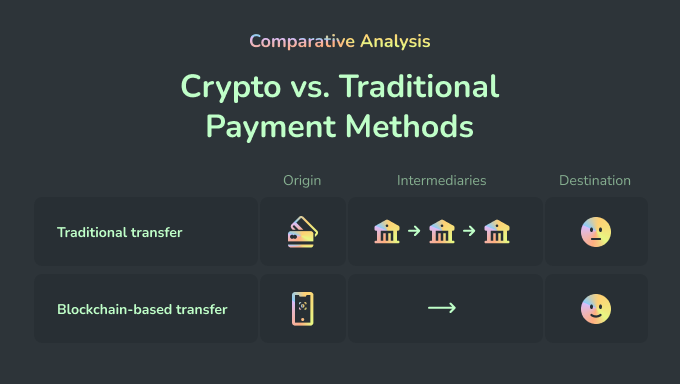

Crypto vs. Traditional Payment Methods: A Comparative Analysis
Sep 22, 2023
7 min read
Contents
Advantages of Cryptocurrencies
Drawbacks of Cryptocurrencies
Advantages of Traditional Payment Methods
Drawbacks of Traditional Payment Methods
Choosing Between Traditional Banking and Cryptocurrency
The Future of Payments
Conclusion
Share
In an increasingly digital world, the realm of financial transactions has been reshaped by the emergence of cryptocurrencies. These digital assets have ignited debates about their potential to replace or complement traditional payment methods. This article delves into a comparative analysis of crypto and traditional payment systems, exploring their advantages, drawbacks, and the broader implications for the future of global finance.

Advantages of Cryptocurrencies
Decentralization and Autonomy: Cryptocurrencies operate on decentralized networks, eliminating the need for intermediaries like banks. This autonomy empowers users to have direct control over their funds and transactions, reducing dependency on centralized authorities.
Global Accessibility: Traditional payment methods are often limited by geographical borders and currency conversions. Cryptocurrencies, on the other hand, can be accessed and utilized globally, facilitating cross-border transactions without the hassle of currency exchange.
Enhanced Security: Blockchain technology, the foundation of cryptocurrencies, offers robust security features. Transactions are recorded on a tamper-resistant digital ledger, minimizing the risk of fraud, identity theft, and unauthorized access.
Lower Transaction Costs: Cryptocurrency transactions often involve lower fees compared to traditional methods, which may involve intermediary fees, currency conversion costs, and international transaction charges.
Drawbacks of Cryptocurrencies
Volatility: Cryptocurrencies are notorious for their price volatility. The value of digital assets can fluctuate significantly within short timeframes, posing risks for both investors and everyday users.
Limited Acceptance: While the adoption of cryptocurrencies is growing, they are still not universally accepted. Users might encounter challenges finding merchants or businesses that support crypto payments.
Regulatory Uncertainty: Cryptocurrency regulations vary widely across jurisdictions. The lack of consistent regulations can create legal uncertainties, affecting businesses' willingness to adopt cryptocurrencies.
Advantages of Traditional Payment Methods
Familiarity and Wide Acceptance: Traditional payment methods like credit cards, debit cards, and bank transfers are widely accepted and familiar to the majority of consumers and businesses.
Price Stability: Traditional currencies, backed by governments, tend to be more stable in value compared to cryptocurrencies. This stability can be crucial for day-to-day financial transactions and long-term planning.
Regulatory Protection: Traditional payment methods are subject to established regulatory frameworks that offer consumer protections, fraud prevention, and mechanisms for dispute resolution.
Drawbacks of Traditional Payment Methods
Intermediaries and Delays: Traditional payment systems often involve intermediaries, leading to delays in transaction processing. International transfers can take several business days to complete.
High Fees: International transactions and currency conversions can attract high fees, especially when involving multiple financial institutions in the process.
Privacy Concerns: Traditional payment methods require the disclosure of personal and financial information, raising concerns about data privacy and security breaches.
Choosing Between Traditional Banking and Cryptocurrency
Determining whether traditional banking or cryptocurrency is the better option hinges on your individual needs and preferences. Both approaches have their strengths and weaknesses, making the decision contingent on what aligns best with your requirements. Opting for cryptocurrency might be suitable if you prioritize transparency, security, and decentralization. Conversely, if regulation and customer service matter more to you, and you value the familiarity of conventional systems, traditional banking could be the preferable route.
It's crucial to note that while cryptocurrencies offer numerous benefits, they also come with risks. Their extreme volatility can lead to rapid and drastic changes in value. Furthermore, the potential for fraud and cyberattacks exists, and due to the lack of regulation, investors are left without protection. In contrast, traditional banking systems offer stability, security, and regulatory oversight. Your assets are protected, and assistance is readily available through customer service. Nonetheless, traditional banking systems can be slow and expensive, and they too can be vulnerable to fraud and cyber threats.
Ultimately, the choice between traditional banking and cryptocurrency depends on your risk tolerance, priorities, and long-term financial goals. It's advisable to carefully evaluate the pros and cons of each option and seek expert advice if needed before making an informed decision that aligns with your financial well-being.
The Future of Payments
The ongoing evolution of financial technologies continues to reshape the payments landscape. While cryptocurrencies offer innovation and increased financial autonomy, they must overcome challenges related to regulation, volatility, and adoption. Traditional payment methods, backed by established financial systems, provide stability and familiarity but can suffer from issues related to fees, delays, and privacy.
In this dynamic landscape, the synergy between cryptocurrencies and traditional payment methods is gaining momentum. The integration of cryptocurrencies into traditional systems, like using crypto-enabled debit cards, aims to bridge the gap between the advantages of both worlds. Additionally, innovative fintech companies like Inqud are working to create seamless solutions that enable users to integrate cryptocurrencies into their daily lives alongside traditional currencies.
Conclusion
In conclusion, the comparison between cryptocurrencies and traditional payment methods reveals a spectrum of advantages and challenges for each. The future of payments may very well involve a harmonious coexistence of both, offering users greater choice and flexibility while navigating the intricacies of an ever-evolving financial landscape.
Industries
SMB, IMB
Products
API, Crypto widget, Сard2crypto
Tags
Payment methods, Fiat, Cryptocurrency, local payments
Author
Alexandra Sokolova
,
Crypto Content Writer